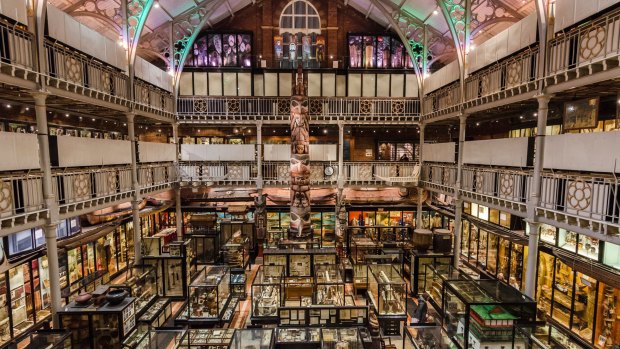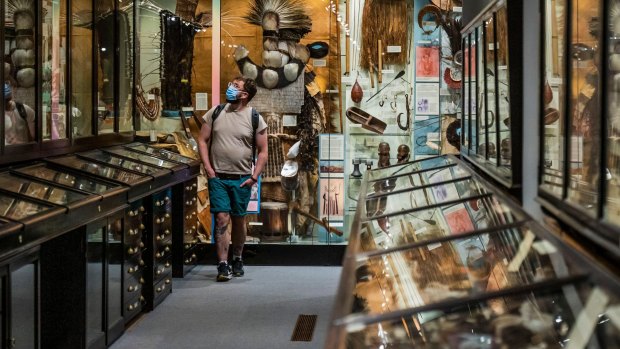This was published 1 year ago
Mind-boggling museum contains objects you won’t believe
By Tim Elliott

Augustus Henry Lane Fox Pitt Rivers collected some 22,000 artefacts over the yeras, all of which he donated to the University of Oxford on the condition that it build a museum to house them all.Credit: Alamy
I was 12 years old in 1981 when the movie Raiders of the Lost Ark came out. There are several things I remember about it, including the elfin bar owner Marion Ravenwood (played by Karen Allen), drinking a Nepalese yak herder under the table, and the fly-by-night anthropologist Indiana Jones being chased by Amazonian tribesmen. There was also that fedora and the whip, the many applications of which - lassoing girls, lashing Nazis - never ceased to amaze me.
Like so many other aspiring adventurers, the film fired something deep within me, an atavistic urge to seek out foreign cultures and far away places. Sadly, I didn't become an anthropologist or an archaeologist: I've never owned a whip and look like an idiot in a hat. I have, however, in the course of my journalism been lucky enough to work in some remote and dangerous places, including the Papua New Guinea highlands, the Amazon jungle and Manly Corso on a Saturday night. And yet there was one destination that had eluded me, until recently. A trip to the Pitt Rivers Museum, in Oxford, England.
The words Oxford and adventure don't immediately go together, but in the annals of archaeology, the Pitt Rivers is a special place. The museum, which was founded in 1884, is named after one Augustus Henry Lane Fox Pitt Rivers, a stately, mutton-chopped officer in the British army, who over the course of a 32-year military career (Crimea, Malta, Canada, Ireland), collected some 22,000 artefacts, all of which he donated, in 1884, to the University of Oxford, on the condition that it build a museum to house them all.

The museum is now in the thick of what it calls a "decolonisation" process, and is engaging with different cultural groups worldwide to find the best way to return objects that were taken unfairly.Credit: Alamy
The building alone is worth seeing - a large, collonaded rectangular room with two mezzanine levels and a huge, vaulted ceiling. It is a freezing day in December when I turn up with my 14-year-old daughter. Outside it is snowing delicately, dainty flakes descending like dander; inside it is another world, warm and whisper quiet, every available space busy with glass display cases and exhibits. The museum now houses 500,000 artefacts across myriad periods and places, an astonishing array of the arcane and esoteric: Ethiopian priest crowns, African love charms; voodoo dolls, reindeer kickers; an entire cabinet of Algerian surgical instruments from 1913, including hooks, pincers and skull drills (with chunks of the patients' craniums). Each item is accompanied by a tiny label with a brief description, handwritten by the person who first accessioned them, in some cases more than 130 years ago. Even the labels are old.
It sounds strange, but for all its pomp and history, the Pitt Rivers is a very trippy place. The pieces here are quite literally mind boggling, in the sense that you would never - could never - imagine that they actually existed. At one stage I come across what looks like a tiny white saw, the size of a matchbox. Peering closer, I read the label: "Fish jaw for nicking the poisoned ends of blow-gun darts, to make them break off in the animal [collected in 1906, Peru]". Next to it is a box containing what looks like two wizened up little hands. "Pair of fore-feet of mole," reads the label, "cut from animal while alive (which is then allowed to go away). These were carried in the pocket of an old man in the village in belief that he would be permanently freed from toothache." Then, just next to that, a spiky brown blob: "Object, said to be a toad, stuck with thorns for witchcraft purposes." Very Indiana Jones.
Of course, the museum is inextricably linked to British imperialism, an age when gentlemen adventurers felt it within their rights to go out into the world, and… take stuff, often violently. The museum is now in the thick of what it calls a "decolonisation" process, and is engaging with different cultural groups worldwide to find the best way to return objects that were taken unfairly. In 2022, after five years of negotiations, the museum, together with the neighbouring Oxford University Museum, returned 17 Aboriginal ancestors to the Australian government. Meanwhile, other human remains, including a collection of shrunken heads from South America, have been removed from the Pitt Rivers display and put in storage.
I could have spent a week in the museum, wandering around, getting lost, being amazed. But after four hours, my daughter has reached peak-history. I come around the corner from the weapons exhibit (arquebuses, samurai swords, antique grenades), and find her slouched against the wall. She says she needs a hot chocolate, "right now". And so we go back out, into the snow. It is only 3pm, but already dusk. I ask her what she likes most about the museum, and she says all of it. "I can't believe how much there was," she says. I say "there's even more out there, in the world, still to discover."
"I know," she says, rubbing hands together. "And all you have to do is keep your eyes open."
Pitt Rivers Museum, mission accomplished.
MORE
Pitt Rivers Museum, South Parks Rd, Oxford. See prm.ox.ac.uk/
As with all museums in Britain, entry is free, except for groups of 10 or more, which cost £1.50 ($2.70) a person.
The writer travelled at his own expense.
Sign up for the Traveller Deals newsletter
Get exclusive travel deals delivered straight to your inbox. Sign up now.